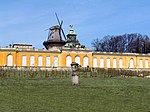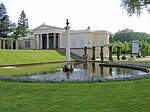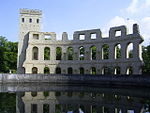Chinese House (Potsdam)

The Chinese House (German: Chinesisches Haus) is a garden pavilion in Sanssouci Park in Potsdam, Germany. Frederick the Great had it built, about seven hundred metres southwest of the Sanssouci Summer Palace, to adorn his flower and vegetable garden. The garden architect was Johann Gottfried Büring, who between 1755 and 1764 designed the pavilion in the then-popular style of Chinoiserie, a mixture of ornamental rococo elements and parts of Chinese architecture.The unusually long building time of nine years is attributed to the Seven Years' War, during which Prussia's economic and financial situation suffered significantly. Only after the end of the war in 1763 were the chambers inside the pavilion furnished. As the building served not only as a decorative piece of garden architecture but also as a setting for small social events, Frederick the Great ordered the building of a Chinese Kitchen, a few metres south-east of the Chinese House. After a conversion in 1789, only the hexagonal windows show the Oriental character of the former outbuilding. A few years later, the Dragon House was built in the form of a Chinese pagoda on the northern edge of Sanssouci Park bordering Klausberg. The building was Frederick the Great's attempt to follow the Chinese fashion of the 18th century, which began in France before spreading to England, Germany, and Russia.
Excerpt from the Wikipedia article Chinese House (Potsdam) (License: CC BY-SA 3.0, Authors, Images).Chinese House (Potsdam)
Jagowweg, Potsdam Bornstedt
Geographical coordinates (GPS) Address Nearby Places Show on map
Geographical coordinates (GPS)
| Latitude | Longitude |
|---|---|
| N 52.400277777778 ° | E 13.031944444444 ° |
Address
Park Sanssouci
Jagowweg
14469 Potsdam, Bornstedt
Brandenburg, Germany
Open on Google Maps











